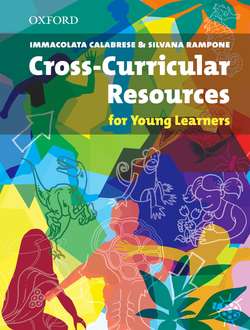Читать книгу Cross-Curricular Resources for Young Learners - Immacolata Calabrese - Страница 2
На сайте Литреса книга снята с продажи.
THE PURPOSE OF THIS BOOK
ОглавлениеThis book is intended as a resource book for teachers of English in primary schools. It contains a range of activities which will help you to vary or expand the materials provided by course books.
It is generally recognized that linguistic diversity is as vital a component of a civilization as economic activities and religious and civil customs. It is believed that the learning of language and content in conjunction provides many opportunities for learning language indirectly; it enables children to learn more quickly and to reach a higher level of knowledge than a traditional approach does. In recent years the recognition of the potential of Content and Language Integrated Learning (CLIL), whereby the children study a subject in a foreign language, has persuaded many researchers to carry out experimental projects whose aims may be summarized as follows:
• To learn not just to use a foreign language but to use a foreign language as a tool for learning.
• To increase motivation for learning a foreign language or for learning other subjects through that language.
• To improve the effectiveness of foreign language learning and to acquire a better knowledge of other subjects.
• To provide opportunities for using the foreign language in practical and motivating contexts, while stimulating comprehension, production, and interaction in a natural way.
• To economize on time by contextualizing learning and combining strands of different subjects in the same curricula.
• To use abilities, knowledge, and skills from other disciplines (not just the linguistic ones).
• To exploit the children’s mixed abilities and learning styles.
• To develop the social skills of co-operation and taking turns.
Content and language integrated experiences in primary schools do not necessarily mean teaching a whole subject in a foreign language but selecting, within that subject, some significant areas to be exploited and developed in a foreign language. One can either develop language by choosing a topic the children are studying in their own language and then integrating it with activities in the foreign language, or use foreign language knowledge which they have already acquired to teach them new content of a subject in the foreign language. A subject can be initially introduced in mother tongue and later expanded on in the foreign language, or vice versa. What is important is that there should not be a simple transposition of activities from one language to another, but that the activities in the two languages complement one another. For some examples of CLIL projects around the world, taught through English, see http://www.factworld.info/http://www.factworld.info/
HOW TO USE THIS BOOK
The book contains teaching plans which can be used in different contexts with children of various age groups. It is up to you to select activities and materials and to fit them into your own course syllabus, adapting them to your children’s needs, and cognitive and linguistic competences.
Each teaching plan is structured according to a cross-curricular approach which makes it possible either to use all the activities or to select just some of them, in accordance with the needs of the class. An effective approach to CLIL at primary level can be summarized as follows:
a) Exploit the children’s previous linguistic and subject knowledge.
b) Place the initial emphasis on listening and comprehension.
c) Facilitate foreign language comprehension by:
• creating a reassuring environment in which the children can express themselves without anxiety
• pre-teaching vocabulary
• using age-appropriate vocabulary
• reinforcing linguistic structures that have already been learnt
• using visual supports (pictures, flashcards, PowerPoint presentations, etc.), miming, and gestures
• code-switching (shifting from one language to another as a natural communicative strategy) to explain a concept, overcome a breakdown in communication, or introduce a complex topic
• constantly checking progress and providing feedback
• paraphrasing, reformulating, simplifying, and giving examples
d) Facilitate foreign language production by:
• allowing children to answer in different ways (from non-verbal answers in the early stages to verbal answers, in both mother tongue and in the foreign language, before gradually progressing to the point where children only answer in the foreign language)
• using role-play; group work; songs and games
• making posters, booklets, tables and graphs
e) Use additional activities common to both the new subject and foreign language learning (investigations, making predictions, experiments, data collection, gap filling, matching games, listening, etc.).
